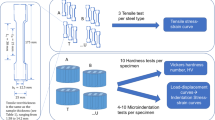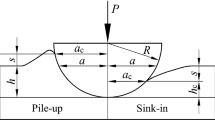Abstract
This study investigates spherical indentation of plastically graded materials (PGMs). The hardness of these materials decreases with depth due to microstructural or compositional changes. To predict the behavior of PGM, the knowledge of the plastic properties of the surface and the substrate is necessary. In this work, the spherical indentation technique is applied on carbonitrided steels to obtain their mechanical properties. First, spherical indentation was applied to characterize homogenous materials using inverse analysis. The comparison with tensile test’s results shows that the inverse analysis using spherical indentation data is a reliable method to determine the plastic properties of homogeneous materials. In the second part spherical indentation was used to characterize carbonitrided steels using inverse analysis to obtain plastic properties of the surface. The results show that spherical indentation using inverse analysis has a real potential for evaluating mechanical properties of PGM.















Similar content being viewed by others
References
Y.P. Cao and J. Lu: A new scheme for computational modeling of conical indentation in plastically graded materials. J. Mater. Res. 19(6), 1703 (2004).
V. Garnier and G. Corneloup: Determining of the evolution of the elasticity modulus by surface wave according to the depth in a nitrided layer. Ultrasonics 34(2–5), 401 (1996).
A.E. Giannakopoulos: Indentation of plastically graded substrates by sharp indentors. Int. J. Solids Struct. 39, 2495 (2002).
A. Nayebi, R. El Abdi, O. Bartier, and G. Mauvoisin: New procedure to determine steel mechanical parameters from the spherical indentation technique. Mech. Mater. 34, 243 (2002).
J.M. Collin, G. Mauvoisin, O. Bartier, R. El Abdi, and P. Pilvin: Use of spherical indentation data changes to materials characterization based on a new multiple cyclic loading protocol. Mater. Sci. Eng., A 501, 608 (2009).
H. Lee, J.H. Lee, and G.M. Pharr: A numerical approach to spherical indentation techniques for material property evaluation. J. Mech. Phys. Solids 53, 2037 (2005).
Y.P. Cao and J. Lu: A new method to extract the plastic properties of metal materials from an instrumented spherical indentation loading curve. Acta Mater. 52, 4023 (2004).
N. Ogasawara, N. Chiba, and X. Chen: Measuring the plastic properties of bulk materials by indentation test. Scr. Mater. 54, 65 (2006).
M. Zhao, N. Ogasawara, N. Chiba, and X. Chen: A new approach to measure the elastic–plastic properties of bulk materials using spherical indentation. Acta Mater. 54, 23 (2006).
J.H. Lee, T. Kim, and H. Lee: A study on robust indentation techniques to evaluate elastic–plastic properties of metals. Int. J. Solids Struct. 47, 647 (2010).
P. Jiang, T. Zhang, Y. Feng, R. Yang, and N. Liang: Determination of plastic properties by instrumented spherical indentation: Expanding cavity model and similarity solution approach. J. Mater. Res. 24(3), 1045 (2009).
N. Ogasawara, N. Chiba, and X. Chen: A simple framework of spherical indentation for measuring elastoplastic properties. Mech. Mater. 41, 1025 (2009).
T. Zhang, P. Jiang, Y. Feng, and R. Yang: Numerical verification for instrumented spherical indentation techniques in determining the plastic properties of materials. J. Mater. Res. 24(12), 3653 (2009).
N.A. Branch, G. Subhash, N.K. Arakere, and M.A. Klecka: A new reverse analysis to determine the constitutive response of plastically graded case hardened bearing steels. Int. J. Solids Struct. 48, 584 (2011).
I.S. Choi, M. Dao, and S. Suresh: Mechanics of indentation of plastically graded materials—I: Analysis. J. Mech. Phys. Solids 56, 157 (2008).
I.S. Choi, A.J. Detor, R. Schwiger, M. Dao, C.A. Schuh, and S. Suresh: Mechanics of indentation of plastically graded materials—II: Experiments on nanocrystalline alloys with grain size gradients. J. Mech. Phys. Solids 56, 172 (2008).
M. Dao, N. Chollacoop, K.J. Van Vliet, T.A. Vankatesh, and S. Suresh: Computational modeling of the forward and reverse problems in instrumented sharp indentation. Acta Mater. 49(19), 3899 (2001).
D. Chicot, L. Gil, K. Silva, F. Roudet, E.S. Puchi-Cabrera, M.H. Staia, and D.G. Teer: Thin film hardness determination using indentation loading curve modelling. Thin Solid Films 518, 5565 (2010).
F. Zhang, R. Saha, Y. Huang, W.D. Nix, K.C. Hwang, S. Ku, and M. Li: Indentation of a hard film on a soft substrate: Strain gradient hardening effects. Int. J. Plast. 23, 25 (2007).
M. Zhao, Y. Xiang, J. Xu, N. Ogasawara, N. Chiba, and X. Chen: Determining mechanical properties of thin films from the loading curve of nanoindentation testing. Thin Solid Films 516, 7571 (2008).
J.A. Knapp and J.F. Browning: Nanoindentation characterization of ErT2 thin films. J. Nucl. Mater. 350, 147 (2006).
A. Nayebi, R. El Abdi, O. Bartier, and G. Mauvoisin: Hardness profile analysis of elasto-plastic heat-treated steels with a gradient in yield strength. Mater. Sci. Eng., A 333, 160 (2002).
T. Nakamura, T. Wang, and S. Sampath: Determination of properties of graded materials by inverse analysis and instrumented indentation. Acta Mater. 18, 4293 (2000).
Y. Gu, T. Nakamura, L. Prchlik, S. Sampath, and J. Wallace: Micro-indentation and inverse analysis to characterize elastic/plastic graded materials. Mater. Sci. Eng., A 345, 233 (2003).
K.L. Johnson: Contact Mechanics (Cambridge University Press, London, 1985).
A.C. Fischer-Cripps: Critical review of analysis and interpretation of nanoindentation test data. Surf. Coat. Tech. 200, 4153 (2006).
M.R. VanLandingham: Review of instrumented indentation. J. Res. Natl. Inst. Stand. Technol. 108, 249 (2003).
Y-T. Cheng and C-M. Cheng: Can stress strain relationship be obtained from indentation curves using conical and pyramidal indenters? J. Mater. Res. 14(9), 3493 (1999).
A.K. Bhattacharya and W.D. Nix: Analysis of elastic and plastic deformation associated with indentation testing of thin films on substrates. Int. J. Solids Struct. 24, 1287 (1988).
X.L. Gao, X.N. Jing, and G. Subhash: Two new expanding cavity models for indentation deformations of elastic strain-hardening materials. Int. J. Solids Struct. 43, 2193 (2006).
O. Bartier, X. Hernot, and G. Mauvoisin: Theoretical and experimental analysis of contact radius for spherical indentation. Mech. Mater. 42, 640 (2010).
P. Pilvin: Approaches multi-échelles pour la prévision du comportement anélastique des métaux. PhD Thesis (ENS Cachan, CRNS, Université Paris 6, France, 1990).
V. Chean, E. Robin, R. El Abdi, J-C Sangleboeuf, and P. Houizot: Use of the mark-tracking method for optical fiber characterization. Optic Laser Technol. 43, 1172 (2011).
Author information
Authors and Affiliations
Corresponding author
Rights and permissions
About this article
Cite this article
Moussa, C., Bartier, O., Mauvoisin, G. et al. Characterization of homogenous and plastically graded materials with spherical indentation and inverse analysis. Journal of Materials Research 27, 20–27 (2012). https://doi.org/10.1557/jmr.2011.303
Received:
Accepted:
Published:
Issue Date:
DOI: https://doi.org/10.1557/jmr.2011.303




